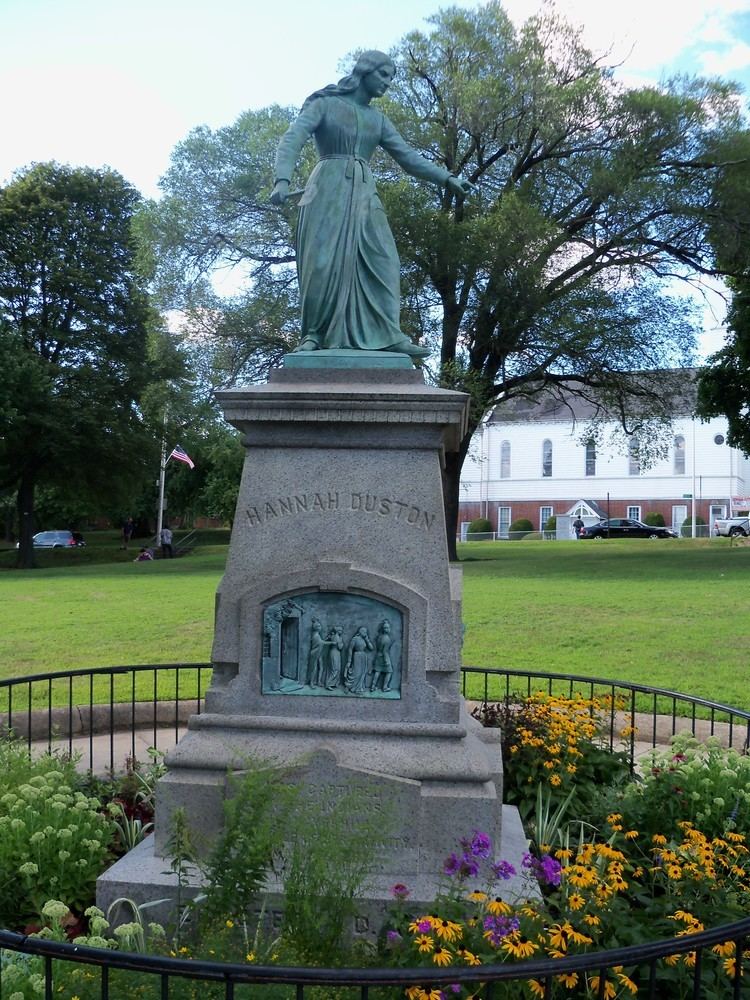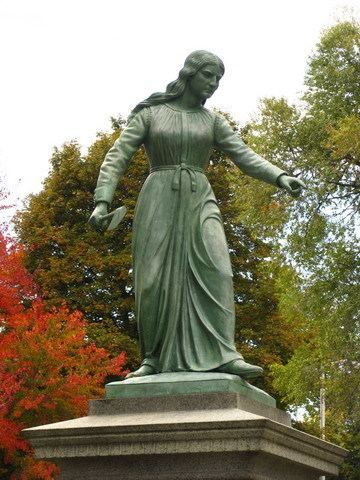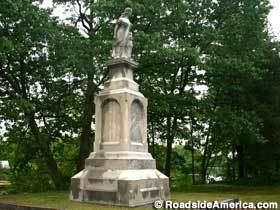Name Hannah Duston | ||
 | ||
Died 1736, Haverhill, Massachusetts, United States | ||
The haverhill journal april 23 2015 the hannah duston anniversary special
Hannah Duston (Dustin, Dustan, and Durstan) (born Hannah Emerson, December 23, 1657 – c. 1737) was a colonial Massachusetts Puritan mother of nine who was taken captive by Abenaki people from Québec during King William's War, with her newborn daughter, during the Raid on Haverhill in 1697, in which 27 colonists were killed. While detained on an island in the Merrimack River in present-day Boscawen, New Hampshire, she killed and scalped ten of the Native family members holding them hostage, with the assistance of two other captives.
Contents
- The haverhill journal april 23 2015 the hannah duston anniversary special
- The unevening 5 hannah duston
- The Tale of Hannah Duston Mar 28 2018 The Haverhill Journal On the Go
- Biography
- Written accounts
- Memorials
- Duston hatchet
- Commemorative structures
- Controversy
- References

Duston's captivity narrative became famous more than 100 years after she died. Duston is believed to be the first American woman honored with a statue. During the 19th century, she was referred to as "a folk hero" and the "mother of the American tradition of scalp hunting". Some scholars assert Duston's story only became legend in the 19th century because the United States used her story to defend its violence against Native Americans as innocent, defensive, and virtuous.

The unevening 5 hannah duston
The Tale of Hannah Duston - Mar. 28, 2018 - The Haverhill Journal On the Go
Biography

Hannah Emerson was the oldest of 15 children. At age 20, she married Thomas Duston, a farmer and brick-maker. The Emerson family had previously been the subject of attention when Elizabeth Emerson, Hannah's younger sister, was hanged for infanticide.

During King William's War, Hannah, her husband Thomas, and their eight children were residents of Haverhill, Massachusetts. In March 1697, the town was attacked by a group of Abenaki from Quebec. In the attack, 27 colonists were killed, and 13 were taken captive to be either adopted or held as hostages for the French. When their farm was attacked, Thomas fled with eight children, but Hannah and her nurse, Mary Neff (nee Corliss), were captured and forced to march into the wilderness, Hannah carrying her newborn daughter, Martha. According to the account Hannah gave to Cotton Mather, along the way her captors killed the six-day-old Martha by smashing her head against a tree.
Hannah and Mary were assigned to a family group of 12 persons and taken north. The group included Samuel Lennardson, a 14-year-old captured in Worcester, Massachusetts, the year before.
Six weeks later, at an island in the Merrimack River at the mouth of the Contoocook River, near what is now Penacook, New Hampshire, Hannah led Mary and Samuel in a revolt. Hannah used a tomahawk to attack the sleeping captors, killing one of the two grown men (Lennardson killed the second), two adult women, and six children. One severely wounded Abenaki woman and a young boy managed to escape the attack.
The former captives immediately left in a canoe, but not before taking scalps from the dead as proof of the incident and to collect a bounty. They traveled downriver, only during the night, and after several days reached Haverhill. The Massachusetts General Court later gave them a reward for killing their captors; Hannah Duston received 25 pounds, and Neff and Lennardson split another 25 pounds (various accounts say 50 or 25 pounds, and some accounts mention only Duston's receiving an award).
Hannah lived for nearly 40 more years.
Written accounts
The event became well known, due in part to Cotton Mather's account in Magnalia Christi Americana: The Ecclesiastical History of New England (1702). Duston became more famous in the 19th century as her story was retold by Nathaniel Hawthorne, John Greenleaf Whittier, and Henry David Thoreau.
Memorials
There are six memorials to Hannah Duston.
The campaign to build the first monument in Haverhill, Massachusetts, began in 1852, at a time when building public monuments was still a somewhat rare occurrence. The monument chosen was a simple marble column that would cost about $1,350, and by 1861 the necessary funds had been raised. The monument was erected in June 1861, at the site of Duston's capture, but it was never fully paid for. After successfully suing the association, the builders removed the monument in August 1865, erased the inscription, engraved a new one, and resold it to the town of Barre, Massachusetts, where it stands to this day as a memorial to that town's Civil War soldiers.
Now known as Hannah Duston Memorial State Historic Site, the first Duston memorial actually executed was sculpted by William Andrews, a marble worker from Lowell, Massachusetts. It was erected in 1874 on the island in Boscawen, New Hampshire, where Duston killed her captors. Huge crowds overwhelmed the island on the day of its dedication, with speeches presented all day long. It was the first publicly funded statue in New Hampshire.
In 1879, a bronze statue of Hannah Duston grasping a tomahawk was created by Calvin H. Weeks (1834–1907) in Haverhill town square (now Grand Army Park), where it still stands. The monument stands on the site of the Second Church, of which Hannah Duston became a member in 1724.
The third memorial was created in 1908, when an inscription was placed on a boulder in memorial to both Hannah and Martha. The boulder was placed on the site of Hannah's son Jonathan's home, where Hannah lived her final years. Hannah Duston died at this location circa 1736 or 1737.
A mill stone was placed on the shores of the Merrimack River where Hannah, Mary, and Samuel beached their canoe upon their return to Haverhill.
A memorial has been placed at the site of James Lovewell's home, in Nashua, New Hampshire, where Hannah, Mary, and Samuel rested on their way home from captivity.
Duston hatchet
The original small axe or hatchet held by Hannah Duston can be found today in the Haverhill Historical Society. The Duston hatchet is not a tomahawk; it is usually called a Biscayan or biscayenne, a common trade item of the late seventeenth-century New England frontier.
Commemorative structures
Other commemorations, all in the city of Haverhill, include:
Controversy
Today, Hannah Duston's actions in freeing herself from captivity, such as killing the Abenaki family she was staying with, are controversial. Some Americans celebrate her as a hero, while others are more tempered in their commemoration of her, given the killing of her captors. Some commentators have said her legend is racist and glorifies violence.
